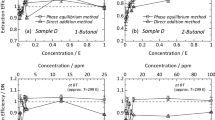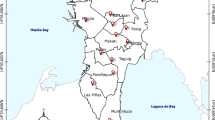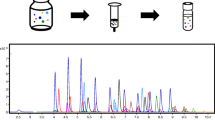Abstract
A new method was developed and optimized for the detection of major “novel” brominated flame retardants (NBFRs), which included decabromodiphenyl ethane (DBDPE), 1,2-bis(2,4,6-tribromophenoxy) ethane (BTBPE), tetrabromobisphenol A-bis(2,3-dibromopropylether) (TBBPA-DBPE), 2-ethylhexyl-2,3,4,5-tetrabromobenzoate (TBB), bis(2-ethylhexyl)-3,4,5,6-tetrabromophthalate (TBPH) and hexachlorocyclopentadienyl-dibromocyclooctane (HCDBCO). Several solid phase sorbents were tested, and finally, a two-step cleanup procedure was established. The first step on activated silica was used to fractionate the dust extracts, while the second step on acidified silica (silica gel impregnated with sulphuric acid 44% w/w) and on Florisil®, respectively, was essential for advanced cleanup. High recoveries for NBFRs (range, 75–94%) were achieved. Analysis was performed by gas chromatography coupled with mass spectrometry in electron capture negative ionization using a DB-5ms (15 m × 0.25 mm × 0.1 μm) capillary column. Quantification of DBDPE, BTBPE and TBBPA-DBPE was based on ion m/z 79, while characteristic ions were used for quantification of TBB (m/z 359), HCDBCO (m/z 310) and TBPH (m/z 384). The method provided good repeatability; within- and between-day precision were ≤14% for all NBFRs. Method limits of quantification ranged between 1 and 20 ng g−1; dust and NBFRs were not detected in blanks. The method was further applied to indoor dust (n = 21) collected from e-waste facilities in Thailand. Except for HCDBCO, all NBFRs were detected in the e-waste dust with concentrations up to 44,000 and 22,600 ng g−1 DBDPE and BTBPE, respectively. The dust profile was dominated by DBDPE (50%) > BTBPE (45%) > TBBPA-DBPE (3%) > TBPH (1.9%) > TBB (0.1%). Significant correlations (p < 0.05) were found between the concentrations of BTBPE and BDE 183 or BDE 197 on the one hand, between TBPH and BDE 47 or BDE 99, and between DBDPE and BDE 209, on the other hand. Concentrations of TBB were not positively correlated with TBPH, which suggests different emission sources.





Similar content being viewed by others
References
Alaee M, Arias P, Sjodin A, Bergman A (2003) Environ Int 29:683–689
de Wit CA (2002) Chemosphere 46:583–624
Hites RA (2004) Environ Sci Technol 38:945–956
Law RJ, Allchin CR, de Boer J, Covaci A, Herzke D, Lepom P, Morris S, Tronczynski J, de Wit CA (2006) Chemosphere 64:187–208
Covaci A, Gerecke AC, Law RJ, Voorspoels S, Kohler M, Heeb NV, Leslie H, Allchin CR, de Boer J (2006) Environ Sci Technol 40:3679–3688
Covaci A, Voorspoels S, Abdallah MAE, Geens T, Harrad S, Law RJ (2009) J Chromatogr A 1216:346–363
Harrad S, de Wit C, Abdallah MAE, Bergh C, Björklund J, Covaci A, Darnerud PO, de Boer J, Diamond M, Huber S, Leonards P, Mandalakis M, Ostman C, Småusten LH, Thomsen C, Webster T (2010) Environ Sci Technol 44:3231–3231
Birnbaum LS, Staskal DF (2004) Environ Health Perspect 112:9–17
van der Ven LTM, van de Kuil T, Verhoef A, Leonards PEG, Slob W, Canton RF, Germer S, Hamers T, Visser TJ, Litens S, Hakansson H, Fery Y, Schrenk D, van den Berg M, Piersma AH, Vos JG (2008) Toxicology 245:109–122
Vonderheide AP, Mueller KE, Meija J, Welsh GL (2008) Sci Total Environ 400:425–436
European Union (2003) The ban of marketing the Penta- and Octa-BDE mixtures. Directive 2003/11/EC of the European parliament and of the council of 6 February 2003 amending for the 24th time Council Directive 76/769/EEC relating to restrictions on the marketing and use of certain dangerous substances and preparations
Renner R (2004) Environ Sci Technol 38:14A
UNEP Stockholm Convention on POPs. Available at http://chm.pops.int/default.aspx
European Court of Justice (2008) Cases C-14/06 and C-295/06, Judgement of the Court, 1 April 2008, Directive 2002/95/EC and Commission Decision 2005/717/EC. Available at http://curia.europa.eu. Accessed March 2011
Covaci A, Harrad S, Abdallah MAE, Ali N, Law RJ, Herzke D, de Wit CA (2011) Environ Int 37:532–556
Covaci A, Voorspoels S, Ramos L, Neels H, Blust R (2007) J Chromatogr A 1153:145–171
Kolic TM, Shen L, MacPherson K, Fayez L, Gobran T, Helm PA, Marvin CH, Arsenault G, Reiner EJ (2009) J Chromatogr Sci 47:83–91
Zhou SN, Reiner EJ, Marvin C, Kolic T, Riddell N, Helm P, Dorman F, Misselwitz M, Brindle ID (2010) J Chromatogr A 1217:633–641
Zhou SN, Reiner EJ, Marvin C, Helm P, Riddell N, Dorman F, Misselwitz M, Shen L, Crozier P, MacPherson K, Brindle ID (2010) Anal Bioanal Chem 396:1311–1320
Muenhor D, Harrad S, Ali N, Covaci A (2010) Environ Int 36:690–698
Sandau CD, Sojdin A, Davis MD, Barr JR, Maggio VL, Waterman A, Preston KE, Preau JL Jr, Barr DB, Needham LL, Patterson DG Jr (2003) Anal Chem 75:71–77
Stapleton HM, Allen JG, Kelly SM, Konstantinov A, Klosterhaus S, Watkins D, McClean MD, Webster TF (2008) Environ Sci Technol 42:6910–6916
Ricklund N, Kierkegaard A, McLachlan MS (2008) Chemosphere 73:1799–1804
Harrad S, Ibarra C, Abdallah MAE, Boon R, Neels H, Covaci A (2008) Environ Int 34:1170–1175
Sawal G, Feibicke M, Meinecke S, Warmbrunn-Suckrow E, Lepom P (2008) Organohalog Compd 70:2029–2032
WHO (1997) Flame retardants: a general introduction. Environmental health criteria 192. WHO, Geneva
Shi T, Chen SJ, Luo XJ, Zhang XL, Tang CM, Luo Y, Ma YJ, Wu JP, Peng XZ, Mai BX (2009) Chemosphere 74:910–916
Davis EF, Stapleton HM (2009) Environ Sci Technol 43:5739–5746
Harju M, Heimstad ES, Herzke D, Sandanger T, Posner S, Wania F (2009) Emerging “new” brominated flame retardants in flame retarded products and the environment. Report 2462, Norwegian Pollution Control Authority, Oslo, Norway
Acknowledgements
A.C. acknowledges the provision of a postdoctoral fellowship from the Research Scientific Foundation of Flanders (FWO). N.A. thanks the University of Antwerp for financially supporting his Ph.D. studies. D.M. is grateful to the Royal Thai Government for Ph.D. scholarship funding.
Author information
Authors and Affiliations
Corresponding author
Rights and permissions
About this article
Cite this article
Ali, N., Harrad, S., Muenhor, D. et al. Analytical characteristics and determination of major novel brominated flame retardants (NBFRs) in indoor dust. Anal Bioanal Chem 400, 3073–3083 (2011). https://doi.org/10.1007/s00216-011-4966-7
Received:
Revised:
Accepted:
Published:
Issue Date:
DOI: https://doi.org/10.1007/s00216-011-4966-7




